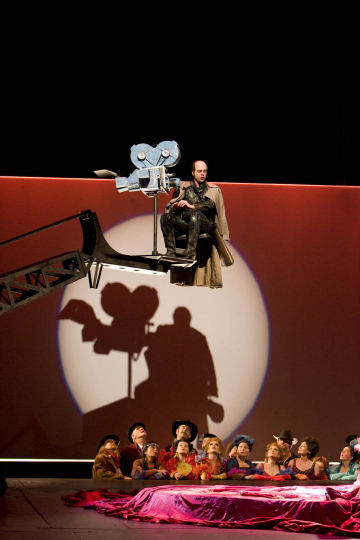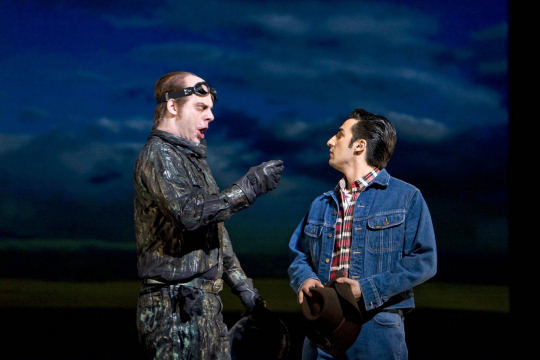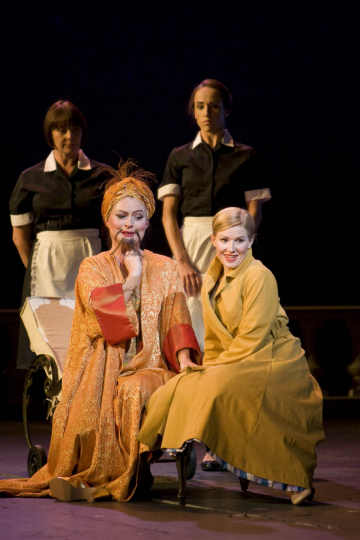Other Links
Editorial Board
- Editor - Bill Kenny
- London Editor-Melanie Eskenazi
- Founder - Len Mullenger
Google Site Search
SEEN
AND HEARD INTERNATIONAL OPERA REVIEW
Stravinsky, The Rake’s Progress:
Soloists, Chorus and Orchestra of
The Royal Opera, Thomas Adès : Conductor , Royal Opera House, Covent
Garden, London 7. 7.2008 (AO)
Like the Hogarth etchings of The Rake’s Progress, which so inspired
Stravinsky when he saw them in Chicago in 1948, the music in this
opera is stark and uncompromisingly spare : black and white, evoking
the moral absolutes in the fable, as much as the Hogarth prints.
It’s interesting to stage. The famous Glyndebourne production of
1975 used the concept of one-dimensional space, so the singers
seemed to jump out of the background like images jumping off paper.
That’s why this staging by the theatre artist Robert Lepage is so
engaging. It’s a spectacular riot of colour, wonderful on the
eye, yet it does bring out other significant elements in the opera,
which is what good direction should do.
Even more striking is the way Lepage creates the magic machine Tom
thinks will turn stone into bread and save the world (while making
him money). It’s a huge television set: feed the public illusion
and they’ll lap it up. As Nick Shadow says, it’s marketing. Inside
the set there’s a film of a small boy in a cowboy suit stealing a
plastic loaf of white bread, so synthetic it bears no resemblance to
real bread.
Baba is such a powerful character that she shines through no matter
what the staging. However, the auction scene doesn‘t have much
impact unless Baba’s role is more sharply delineated. In this
production, she disappears into the pool, which is fair enough, but
audiences who don’t know the plot might wonder why she’s resurrected
among the tawdry possessions being auctioned off. This too is a
crucial scene because it addresses another important theme in the
plot, that material things mean nothing in themselves. That’s
subversive, even now, and would have been all the more so in the
heady days of capitalism, after bleak years of war. Property is
theft unless you’ve earned it. You can’t buy virtue at an auction
any more than you can buy the Roman bust the auctioneer holds on
high. The crowd scenes were well choreographed, as is always the
case at the Royal Opera House, but in the libretto, the crowd is
evil, getting their kicks from Ton’s distress. Perhaps the black
costumes were meant to evoke vultures, which would be apt. But I
suspect they were meant to imply that Baba was dead, though she’s
not.
Cast:
Sally Matthews : Anne Trulove
Tom Rakewell : Charles Castronovo
Darren Jeffrey : Trulove
Mother Goose : Kathleen Wilkinson
John Relyea : Nick Shadow
Patricia Bardon ; Baba The Turk
Peter Brandon : Sellem the auctioneer
Joanathan Coad : Madhouse keeper
Thomas Adès : Conductor
The Royal Opera House Orchestra and Chorus
Robert Lepage: Director
Carl Fillion : Set designer

The Filming Sequence - John Relyea as Nick Shadow
The idea of transposing The Rake’s Progress to Hollywood is
perfectly valid as Stravinsky was fascinated by “the new world” of
America in the 1940’s and 50’s. The real drama in this opera is
between decadence and purity. Even Hogarth’s London is symbolic
rather than factual, so the idea of Hollywood is perfectly sensible.
As W H Auden said, the story is “A myth - it represents a situation
in which all men, at least potentially, find themselves in so far as
they are human beings”.
Lepage’s Hollywood setting is also valid because it captures the
fundamental anti-naturalism in the opera. Film isn’t reality, but
facsimile. Tom Rakewell’s mistake is to be taken in by surface
appearances, instead of true values. What you see is not what you
get. Nick Shadow convinces Tom that’s he’s a charming “servant”, but
he’s really the Devil. So Tom gets sucked in, even though at heart
he’s still basically a good person, as even Baba the Turk can see. The
Hollywood staging allows some wonderful moments. The first scene
comes straight out of Oklahoma!, the wide open horizon
symbolising the prospects before Tom and Anne. Even more
trenchantly, Nick Shadow is seen filming the action from up high on
a camera rig. He’s “directing” the other characters, pulling their
strings as though they are puppets. This expresses so well the sense
of devious plot within plot that runs through this opera. Tom
doesn’t notice the production crew with their booms and continuity
boards.

John Relyea (Nick Shadow) and Charles Castelnovo (Tom Rakewell)
However, the very spectacle of this production leads to weaknesses.
The brilliance of the first act starts to unravel in the scene where
Baba The Turk and Tom sit by the swimming pool. Maybe this is
Sunset Boulevard, but Baba is no deluded diva. The role may
seem small but it is in fact pivotal. Baba is a counterfoil to Nick
Shadow. He’s charming, she’s unloved. He’s seductive, she’s ugly.
He’s respected, she’s sneered at. Yet she’s the real heroine, even
more so than Anne Truelove. It’s she who sees through Nick and Tom
and helps Anne understand the heart of the fable. And it’s she who
can walk away from the disaster, because she has genuine strength of
character. Baba may babble, but Baba survives!

Patricia Bardon (Baba The Turk) and Sally Matthews (Anne
Trulove)
The lushness of this staging was impressive, and might have worked
even better had the music fought back better. To use the Hollywood
metaphor, this was a shoot out between staging and opera. Stravinsky
uses baroque orchestration for a purpose. This is music to listen to
if you don’t believe harpsichords can do extreme atonal dissonance.
Neo classical formality may shape the opera, but this is modern
music, where old serves new. Harpsichords are vulnerable voices,
easily overwhelmed. Just as virtue is vulnerable, overwhelmed by
vice. Stravinsky expresses the moral dilemma in his music. John
Eliot Gardiner’s recording brings out the chamber-like fragility in
the orchestral textures very well. Adès got good playing from this
orchestra, but his approach was more luxuriant, in keeping with the
lushness of the staging rather than acting as caustic counter
balance. In a more minimalist production, it would have been fine,
but here a bit more savagery would have helped. The Hollywood
Lepage evokes wasn’t paradise. McCarthy was hunting down artists and
destroying people who didn’t conform to the rampant capitalist ethic
this opera trenchantly derides. The Rake’s Progress is
disturbing and even subversive. But there was little sense of
danger in this production. For a moment, there was a hint of a
“mushroom cloud” exploding in the centre of the stage. But it turned
into a balloon shaped like a movie star trailer.
The singers, too, had to contend with the larger than life Hollywood
presence. Significantly, Sally Matthews, as Anne Trulove, stood out
well, for “innocent country girl” automatically undercuts
extravaganza. There’s less distraction around her role, so Matthews
come through more clearly. John Relyea’s Nick Shadow was strong
enough to stand out too, and was sung with magnificent menace. This
text is a challenge, conversational yet twisted, syntax and rhythms
wavering wildly. It’s not an easy part and needs someone like
Relyea who understands how it works. He will certainly be sing Nick
Shadow again as he’s still under 40 and it’s a role made for a voice
with this range of authority and subtle nuance. In a production
where more emphasis is placed on the singers, he would be
exceptional.
This Rake’s Progress is definitely worth experiencing as it’s
very different. Friends of mine who attended shared my misgivings
about its representation of the music, but as theatre it works
extremely well. Indeed, a good friend of mine who didn’t know the
opera before was absolutely thrilled. That’s a very good thing
indeed, as any production that can make someone want to find out
more and listen again deserves respect.
Pictures ©
Back to Top Cumulative Index Page
